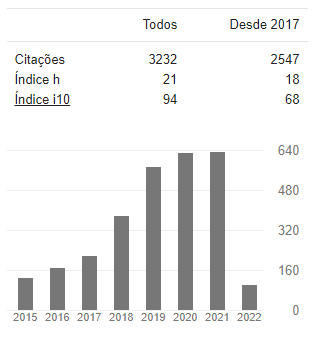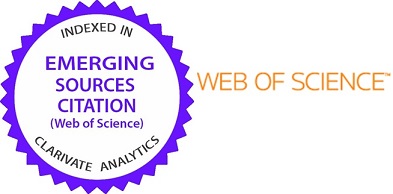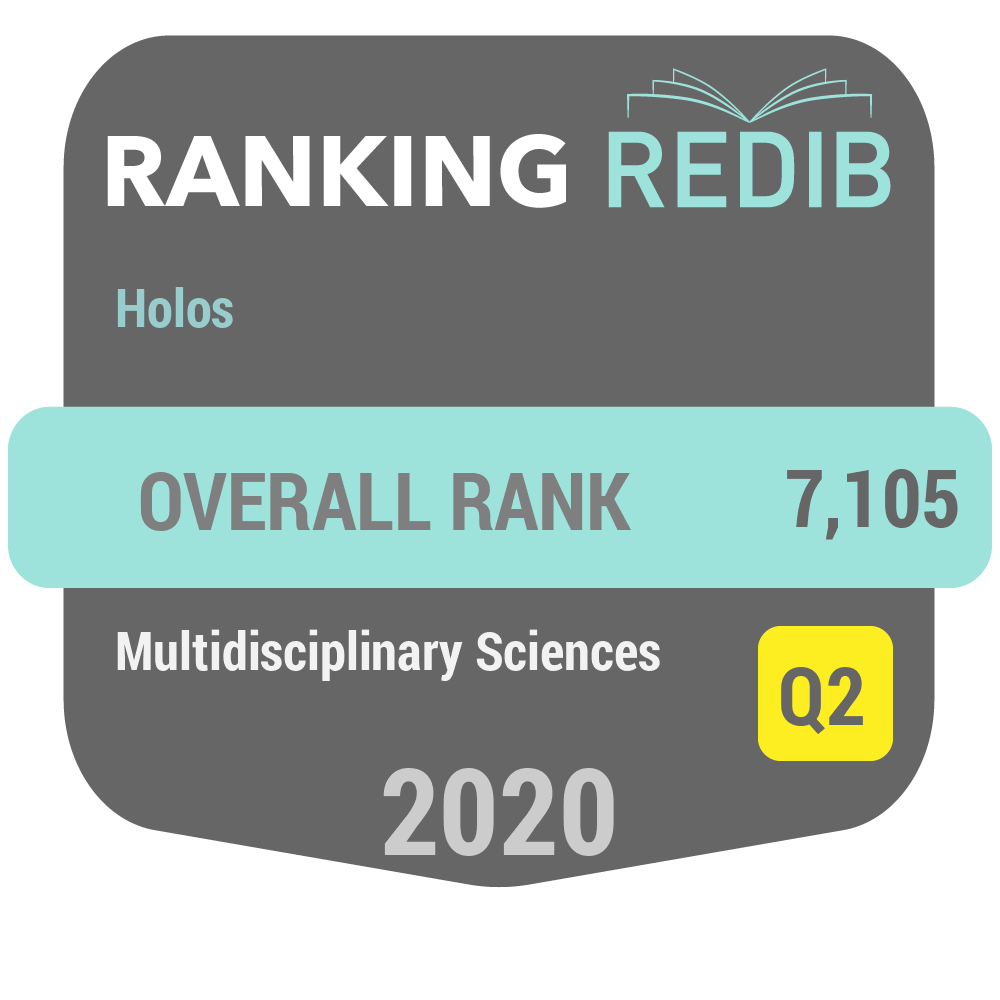EFFECTS OF THE INCREASE IN SUBSTRATE LOAD AND HYDROLYSIS TIME IN THE SACCHARIFICATION OF SUGARCANE BAGASSE AND ETHANOL PRODUCTION
DOI:
https://doi.org/10.15628/holos.2020.9485Palavras-chave:
Resíduos agrícolas, Lignocelulose, BioetanolResumo
In this study, the enzymatic saccharification of alkaline pretreated sugarcane bagasse (PSB) and the production of second generation bioethanol were investigated under different conditions. The effects of percentage of dry substrate (3 and 10% w/v) and time of hydrolysis (24 and 72 h) were evaluated in order to obtain maximum contents of total reducing sugar (TRS), glucose and xylose. The monosaccharide concentrations were quantified by High Performance Liquid Chromatography (HPLC) and TRS by the 3.5-dinitrosalicylic acid (DNS) method. The saccharification of PSB with the Cellic Ctec3, promoted an efficient release of sugars. Among the four evaluated conditions, the hydrolysis HD (10% PSB and 72h) was selected as the most efficient with the highest concentrations of released sugars: TRS (73.96 g/L), glucose (31.78 g/L) and xylose (10.85 g/L). The alcoholic fermentation of hydrolysate HD with the yeast Saccharomyces cerevisiae produced the maximum concentration of 16.15 g/L of ethanol, with a volumetric productivity (QP) of 0.69 g/Lh and yield of ethanol as a function of the substrate (YP/S) of 0.48 gethanol/gsugar. S. cerevisiae was capable of fermenting 99.96% of glucose from hydrolysate HD. These results suggest that the increase of the substrate load and time in the enzymatic hydrolysis can be favourable alternatives to improve the sugar yields in hydrolysates and, consequently, the bioethanol production.
Downloads
Referências
Antil, P. S., Gupta, R., & Kuhad, R. C. (2014). Simultaneous saccharification and fermentation of pretreated sugarcane bagasse to ethanol using a new thermotolerant yeast. Annals of Microbiology, 65(1), 423–429. https://doi.org/10.1007/s13213-014-0875-2
Brito, P. L., Ferreira, C. M. de A., Silva, A. F. F., Pantoja, L. D. A., Nelson, D. L., & Dos Santos, A. S. (2017). Hydrolysis, detoxification and alcoholic fermentation of hemicellulose fraction from palm press fiber. Waste and Biomass Valorization, 0(0), 1–12. https://doi.org/10.1007/s12649-017-9882-4
de Andrade, L. G. A., Maitan-Alfenas, G. P., Morgan, T., Gomes, K. S., Falkoski, D. L., Alfenas, R. F., & Guimarães, V. M. (2017). Sugarcane bagasse saccharification by purified ?-glucosidases from Chrysoporthe cubensis. Biocatalysis and Agricultural Biotechnology, 12, 199–205. https://doi.org/10.1016/j.bcab.2017.10.007
de Sousa Gomes, K., Maitan-Alfenas, G. P., de Andrade, L. G. A., Falkoski, D. L., Guimarães, V. M., Alfenas, A. C., & de Rezende, S. T. (2017). Purification and Characterization of Xylanases from the Fungus Chrysoporthe cubensis for Production of Xylooligosaccharides and Fermentable Sugars. Applied Biochemistry and Biotechnology, 182(2), 818–830. https://doi.org/10.1007/s12010-016-2364-5
Ghose, T. K. (1987). Measurment of cellilase activities. Pure and Applied Chemistry, 59(2), 257–268. https://doi.org/https://doi.org/10.1351/pac198759020257
Guerrero, A. B., Ballesteros, I., & Ballesteros, M. (2018). The potential of agricultural banana waste for bioethanol production. Fuel, 213(April 2017), 176–185. https://doi.org/10.1016/j.fuel.2017.10.105
Huang, Q., Yan, Q., Fu, J., Lv, X., Xiong, C., Lin, J., & Liu, Z. (2016). Comparative study of different alcoholate pretreatments for enhanced enzymatic hydrolysis of sugarcane bagasse. Bioresource Technology, 211, 464–471. https://doi.org/10.1016/j.biortech.2016.03.067
Jiang, C. X., He, Y. C., Chong, G. G., Di, J. H., Tang, Y. J., & Ma, C. L. (2017). Enzymatic in situ saccharification of sugarcane bagasse pretreated with low loading of alkalic salts Na2SO3/Na3PO4 by autoclaving. Journal of Biotechnology, 259, 73–82. https://doi.org/10.1016/j.jbiotec.2017.08.004
Martín, C., Galbe, M., Wahlbom, C. F., Hahn-Hägerdal, B., & Jönsson, L. J. (2002). Ethanol production from enzymatic hydrolysates of sugarcane bagasse using recombinant xylose-utilising Saccharomyces cerevisiae. Enzyme and Microbial Technology, 31, 274–282.
Miller, G. L. (1959). Use of dinitrosalicylic acid reagent for determination of reducing sugar. Analytical Chemistry, 31(3), 426–428. https://doi.org/10.1021/ac60147a030
Moreira, F. S., Machado, R. G., Romão, B. B., Batista, F. R. X., Ferreira, J. S., & Cardoso, V. L. (2017). Improvement of hydrogen production by biological route using repeated batch cycles. Process Biochemistry, 58, 60–68. https://doi.org/10.1016/j.procbio.2017.04.013
Nascimento, V. M., Manrich, A., Tardioli, P. W., de Campos Giordano, R., de Moraes Rocha, G. J., & Giordano, R. de L. C. (2016). Alkaline pretreatment for practicable production of ethanol and xylooligosaccharides. Bioethanol, 2(1), 112–125. https://doi.org/10.1515/bioeth-2016-0008
Nouri, H., Azin, M., & Mousavi, M. L. (2017). Xylan-hydrolyzing thermotolerant Candida tropicalis HNMA-1 for bioethanol production from sugarcane bagasse hydrolysate. Annals of Microbiology, 67(9), 633–641. https://doi.org/10.1007/s13213-017-1292-0
Oliva-Neto, P. De, Dorta, C., Azevedo, F., Gomes, V., & Fernandes, D. (2013). The Brazilian technology of fuel ethanol fermentation – yeast inhibition factors and new perspectives to improve the technology. Formatex, 371–379.
Pathania, S., Sharma, N., & Handa, S. (2017). Immobilization of co-culture of Saccharomyces cerevisiae and Scheffersomyces stipitis in sodium alginate for bioethanol production using hydrolysate of apple pomace under separate hydrolysis and fermentation. Biocatalysis and Biotransformation, 35(6), 450–459. https://doi.org/10.1080/10242422.2017.1368497
Pereira, J. de C., Travaini, R., Paganini Marques, N., Bolado-Rodríguez, S., & Bocchini Martins, D. A. (2016). Saccharification of ozonated sugarcane bagasse using enzymes from Myceliophthora thermophila JCP 1-4 for sugars release and ethanol production. Bioresource Technology, 204, 122–129. https://doi.org/10.1016/j.biortech.2015.12.064
Petrou, E. C., & Pappis, C. P. (2009). Biofuels: a survey on pros and cons. Energy and Fuels, 23(2), 1055–1066. https://doi.org/10.1021/ef800806g
Raj, K.; Krishnan, C. (2019). Improved high solid loading enzymatic hydrolysis of low-temperature aqueous ammonia soaked sugarcane bagasse using laccase-mediator system and high concentration ethanol production. Industrial Crops and Products, 131, 32–40. https://doi.org/10.1016/j.indcrop.2019.01.032
Rodrigues, P. de O., Pereira, J. de C., Santos, D. Q. dos, Gurgel, L. V. A., Pasquini, D., & Baffi, M. A. (2017). Synergistic action of an Aspergillus (hemi-) cellulolytic consortium on sugarcane bagasse saccharification. Industrial Crops and Products, 109, 173–181. https://doi.org/10.1016/j.indcrop.2017.08.031
Sahu, S., & Pramanik, K. (2018). Evaluation and optimization of organic acid pretreatment of cotton gin waste for enzymatic hydrolysis and bioethanol production. Applied Biochemistry and Biotechnology, 186(4), 1047–1060. https://doi.org/10.1007/s12010-018-2790-7
Santos, J. R. A. dos, Souto-Maior, A. M., Gouveia, E. R., & Martín, C. (2010). Comparison of SHF and SSF processes from sugarcane bagasse for ethanol production by Saccharomyces cerevisiae. Quimica Nova, 33(4), 904–908.
Saratale, G. D., Saratale, R. G., Kim, S. H., & Kumar, G. (2018). Screening and optimization of pretreatments in the preparation of sugarcane bagasse feedstock for biohydrogen production and process optimization. International Journal of Hydrogen Energy, 43(25), 11470–11483. https://doi.org/10.1016/j.ijhydene.2018.01.187
Silva, T. A. L., Zamora, H. D. Z., Varão, L. H. R., Prado, N. S., Baffi, M. A., & Pasquini, D. (2017). Effect of steam explosion pretreatment catalysed by organic acid and alkali on chemical and structural properties and enzymatic hydrolysis of sugarcane bagasse. Waste and Biomass Valorization, 0(0), 1–11. https://doi.org/10.1007/s12649-017-9989-7
Singh, A., Sharma, P., Saran, A. K., Singh, N., & Bishnoi, N. R. (2013). Comparative study on ethanol production from pretreated sugarcane bagasse using immobilized Saccharomyces cerevisiae on various matrices. Renewable Energy, 50, 488–493. https://doi.org/10.1016/j.renene.2012.07.003
Travaini, R., Barrado, E., & Bolado-Rodríguez, S. (2016). Effect of ozonolysis parameters on generation of inhibitory compounds and on production of ethanol by Pichia Stipitis and Acetona-Butanol-Ethanol by Clostridium from ozonated and water washed sugarcane bagasse. Bioresource Technology, In press., doi: http://dx.doi.org/10.1016/j.biortech.2016.07. https://doi.org/10.1016/j.biortech.2016.07.028
Valinhas, R. V., Pantoja, L. A., Maia, A. C. F., Miguel, M. G. C. P., Vanzela, A. P. F. C., Nelson, D. L., & Santos, A. S. (2018). Xylose fermentation to ethanol by new Galactomyces geotrichum and Candida akabanensis strains. PeerJ, 6, e4673. https://doi.org/10.7717/peerj.4673
Wanderley, M. C. de A., Martín, C., Rocha, G. J. de M., & Gouveia, E. R. (2013). Increase in ethanol production from sugarcane bagasse based on combined pretreatments and fed-batch enzymatic hydrolysis. Bioresource Technology, 128, 448–453. https://doi.org/10.1016/j.biortech.2012.10.131
Wang, W., Wang, Q., Tan, X., Qi, W., Yu, Q., Zhou, G., Zhuang, X., & Yuan, Z. (2016). High conversion of sugarcane bagasse into monosaccharides based on sodium hydroxide pretreatment at low water consumption and wastewater generation. Bioresource Technology, 218, 1230–1236. https://doi.org/10.1016/j.biortech.2016.07.074





































